The Power of the People
Myles Rosenblum
May 4, 2022

National Party
On May 26th, 1948, D.F. Malan’s National Party, which was allianced with N.C. Havenga’s Afrikaner Party, barely won with a five-seat majority and only 40% of the overall electoral votes. The National Party that came to power was essentially two parties that combined together. One party was rooted in white supremacy and introduced apartheid. The other party was a nationalist party appealing to Afrikaans culture by establishing a common history and a hatred of Britain.

A Shift in the ANC
After the National Party came into power, the African National Congress (ANC) began abandoning its traditional reliance on tactics of moderation such as petitions and deputations. In December 1949, with the support of the ANC Youth League, a new leadership came to power in the ANC. Walter Sisulu was elected secretary-general and a number of Youth Leaguers were elected to the national executive, including Oliver Tambo, Sisulu’s successor. These young minds brought completely different approaches to past problems.
Moderation to Mass Imprisonment
https://www.sahistory.org.za/arch
There is a shift from the older generation of the ANC, who would fight with petitions, speeches, and education, to a more militant younger group of the ANC. This younger group was interested in overcrowding the prison system through civil disobedience.

Separate Representation of Voters Act
“the removal of all Cape Coloureds from the present electoral roll; the drawing up of a new electoral roll for Coloured males able to meet the existing literacy and property qualifications; the holding of separate elections for those on the Coloured roll to select four Whites to represent them in the House of Assembly, one in the Senate and two in the Cape Provincial Council; the establishment of a Board of Coloured Affairs to advise the government on Coloured matters and to act as an intermediary between the Coloured community and the government. The II-member board would be under the direction of a White commissioner and would be made up of eight Coloureds elected in the Cape, and three nominated by the government to represent Natal, the Orange Free State and the Transvaal.”
This blatantly racist act acted as a tipping point in the ANC’s response to the National Party. It was after this act was passed that the younger members of the ANC decided an organized protest must follow.
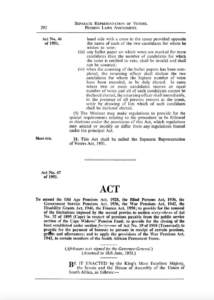
National Day of Pledge and Prayer
On April 6th, 1952, while white South Africans celebrated the 300-year anniversary of Jan van Riebeeck’s arrival at the Cape in 1652, the ANC and SAIC called on black South Africans to observe the day as a “A National Day of Pledge and Prayer”. The majority of Black adults and school children boycotted the festivities.
Day of Volunteers
On June 22nd, 1952, the Sunday before the Defiance Campaign officially began, volunteers signed a pledge:
“I, the undersigned, Volunteer of the National Volunteer Corps, do hereby solemnly pledge and bind myself to serve my country and my people in accordance with the directives of the National Volunteer Corps and to participate fully and without reservations to the best of my ability in the Campaign for the Defiance of Unjust Laws. I shall obey the orders of my leader under whom I shall be placed and strictly abide by the rules and regulations of the National Volunteer Corps framed from time to time. It shall be my duty to keep myself physically, mentally and morally fit.”
Defiance Campaign
On June 26th, 1952 the Defiance Campaign officially began in Bloemfontein. “For the first time Africans and Indians, with a few whites and coloureds were engaging in joint political action under a common leadership.”
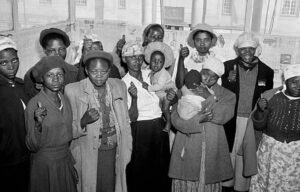
The Growth of the Campaign
The first march was a small group into Boksburg (near Johannesburg) without permits. The group, which included Nelson Mandela and Walter Sisulu, were all arrested and thrown in jail. This was their goal. News spread and soon groups were marching into “Europeans Only” entrances of railway stations, post offices, and other public areas.
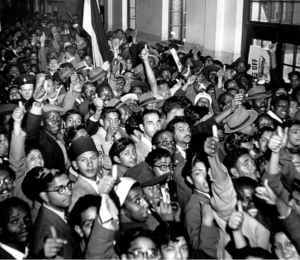
Numbers
During the last few days of June, 146 volunteers were arrested.
July: 504 volunteers
August: 2,015 volunteers
September: 2,058
By December another 2,334 volunteers were arrested.
Total: 8,057 volunteers in less than six months were arrested.
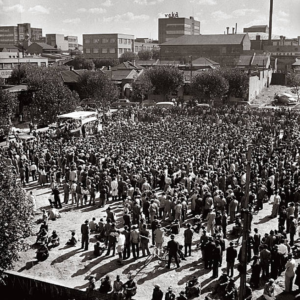
Global Significance
One of the many global effects of the Defiance Campaign was its influence on the Civil Rights Movement in the United States. Civil disobedience and peaceful protests are direct actions taken from the ANC. The video above clearly shows the success of the bus boycotts in South Africa. The infamous photo of Rosa Parks and the Montgomery Bus Boycotts shows how far-reaching the ANC’s protest tactics truly were.
Global Reaction
While the overall goal of systematically dismantling apartheid was not achieved, the Defiance Campaigns were successful both nationally and on a global scale. The Defiance Campaign shined a light on the terror in South Africa and forced the United Nations to recognize that the South African racial policy was an international issue. In addition, a UN Commission was established to investigate how to address the “situation” in South Africa.
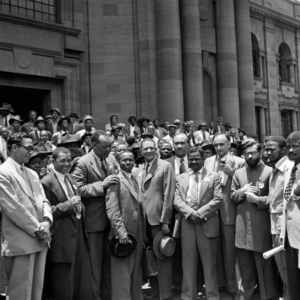
Bibliography
“Freedom For My People”, Z.K. Matthews, Cape Town: Collings, 1981. (Published posthumously in 1981)
“Foreword”, in Responsible Government in a Revolutionary Age, [ed.] Z. K. Matthews, Association Press, New York, 1966.
“Exchange of Correspondence between the African National Congress, the South African Indian Congress, and the Prime Minister of the Union of South Africa between 21 January and 20 February 1952” By D.U. Mistry, Y.A. Cachalla, Y.M. Dadoo, M. Aucamp, W.M. Sisulu, J.S. Moroka.
“Campaign of Defiance against Unjust Laws – Document Collection”.
“Apartheid in South Africa – Documentary on Racism, Interviews with Black and Afrikaner Leaders. 1957.” https://www.youtube.com/watch?v=wdlD-Q9wmfY
“Separate Representation of Voters. Act #46, 1951. Enacted by the Parliament of South Africa.”